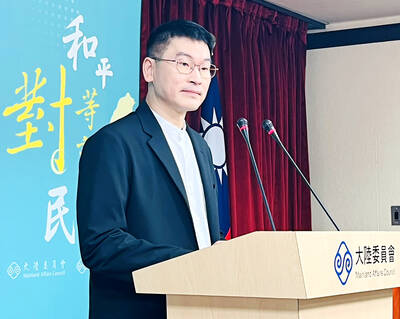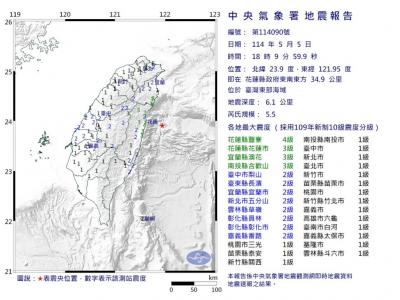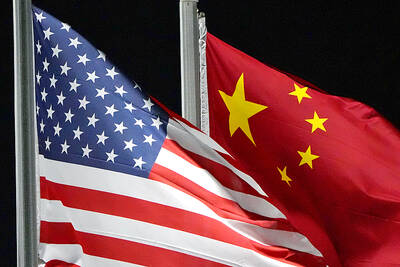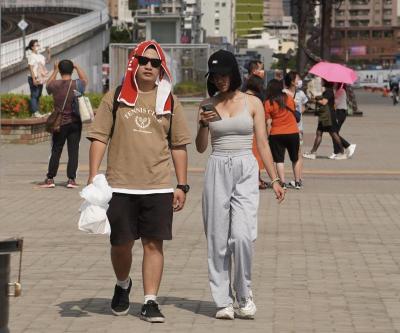Nuclear experts and a legislator yesterday criticized Taiwan Power Co (Taipower ) for its nuclear waste treatment during a visit to the Guosheng Nuclear Power Plant in New Taipei City’s Wanli District (萬里), saying the company’s temporary storage solution is problematic and its management is not transparent.
A visit by nuclear experts and activists to examine the plant’s dry cask storage facilities, a radioactive waste incinerator and a cooling pond was canceled after Taipower denied Japanese nuclear waste expert Masako Sawai access to the facilities due to a visa issue.
Sawai entered Taiwan exempt from a visa, but foreign visitors are required to hold a business visa to enter nuclear facilities, according to Taipower’s rules, which the group said the company deliberately hid from them when they filed Sawai’s application.
Taipower said visitors had been duly informed.
While the visit was canceled, former Institute of Nuclear Energy Research researcher He Li-wei (賀立維) was able to inspect the facilities.
Democratic Progressive Party Legislator Chen Man-li (陳曼麗) said the Legislative Yuan passed a resolution in 2014 to request Taipower revise its protocol for foreign visitors, which she said the company apparently did not do, adding that she would raise a motion to have the company do so immediately.
Despite not being able to personally examine the facilities, Sawai criticized Taipower’s dry cask storage based on its design.
The company plans to store high-level radioactive waste in steel cylinders surrounded by concrete shells placed outdoors as a temporary solution until a permanent depository is constructed.
“Instead of being constructed as a single and seamless piece, the steel cylinder is designed to be welded, but welding points might corrode and crack over an extended period, and the likelihood of corrosion is greater when casks are stored outdoors and exposed to winds containing sea salt,” Sawai said.
The casks should be portable, but Taipower’s concrete cask, each weighing about 200 tonnes, could not be transported in case of an emergency, Sawai added.
“Although concrete casks are 20 percent cheaper than the metal casks used in Japan and many European nations, safety is more important than costs,” she said.
Choosing a storage area that is at close proximity to sea was improper, because casks would be submerged during a tsunami, as was the case with the Fukushima Dai-ichi nuclear disaster, Sawai said.
He criticized the company’s incinerator for burning low-level nuclear waste. He said it runs on diesel instead of plasma torch technology as claimed on the Atomic Energy Council’s Web site.
Incinerators powered by diesel could only reach about 1,000?C, 90 percent lower than the temperature reached by plasma torch, leading to incomplete burning of radioactive waste, He said.
He also criticized the location of a cooling reservoir on a hill above the plant’s two reactors, which is designed to pump water to the cooling system using the force of gravity during a nuclear accident if electrical power is cut, saying that the reservoir was not placed high enough to have the pressure required to pump water into the reactors to prevent a possible meltdown.
“The improper design of the reservoir and incinerator arises from the fact that the designer and supervisor of the nuclear waste treatment are the same institution, which is the Atomic Energy Council’s Institute of Nuclear Energy Research. It is time for the council to be replaced,” he said.

An essay competition jointly organized by a local writing society and a publisher affiliated with the Chinese Communist Party (CCP) might have contravened the Act Governing Relations Between the People of the Taiwan Area and the Mainland Area (臺灣地區與大陸地區人民關係條例), the Mainland Affairs Council (MAC) said on Thursday. “In this case, the partner organization is clearly an agency under the CCP’s Fujian Provincial Committee,” MAC Deputy Minister and spokesperson Liang Wen-chieh (梁文傑) said at a news briefing in Taipei. “It also involves bringing Taiwanese students to China with all-expenses-paid arrangements to attend award ceremonies and camps,” Liang said. Those two “characteristics” are typically sufficient

A magnitude 5.9 earthquake that struck about 33km off the coast of Hualien City was the "main shock" in a series of quakes in the area, with aftershocks expected over the next three days, the Central Weather Administration (CWA) said yesterday. Prior to the magnitude 5.9 quake shaking most of Taiwan at 6:53pm yesterday, six other earthquakes stronger than a magnitude of 4, starting with a magnitude 5.5 quake at 6:09pm, occurred in the area. CWA Seismological Center Director Wu Chien-fu (吳健富) confirmed that the quakes were all part of the same series and that the magnitude 5.5 temblor was

The brilliant blue waters, thick foliage and bucolic atmosphere on this seemingly idyllic archipelago deep in the Pacific Ocean belie the key role it now plays in a titanic geopolitical struggle. Palau is again on the front line as China, and the US and its allies prepare their forces in an intensifying contest for control over the Asia-Pacific region. The democratic nation of just 17,000 people hosts US-controlled airstrips and soon-to-be-completed radar installations that the US military describes as “critical” to monitoring vast swathes of water and airspace. It is also a key piece of the second island chain, a string of

The Central Weather Administration has issued a heat alert for southeastern Taiwan, warning of temperatures as high as 36°C today, while alerting some coastal areas of strong winds later in the day. Kaohsiung’s Neimen District (內門) and Pingtung County’s Neipu Township (內埔) are under an orange heat alert, which warns of temperatures as high as 36°C for three consecutive days, the CWA said, citing southwest winds. The heat would also extend to Tainan’s Nansi (楠西) and Yujing (玉井) districts, as well as Pingtung’s Gaoshu (高樹), Yanpu (鹽埔) and Majia (瑪家) townships, it said, forecasting highs of up to 36°C in those areas